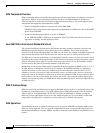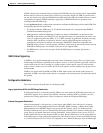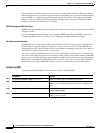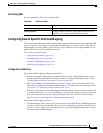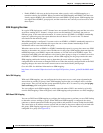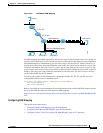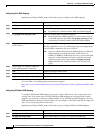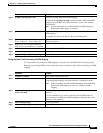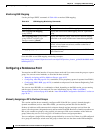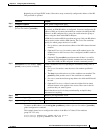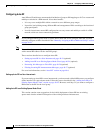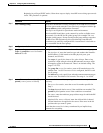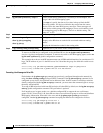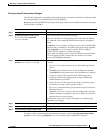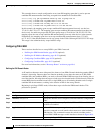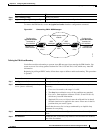
40-22
Cisco ME 3400 Ethernet Access Switch Software Configuration Guide
OL-9639-06
Chapter 40 Configuring IP Multicast Routing
Configuring IP Multicast Routing
Monitoring SSM Mapping
Use the privileged EXEC commands in Table 40-4 to monitor SSM mapping.
Go to this URL to see SSM mapping monitoring examples:
http://www.cisco.com/en/US/products/sw/iosswrel/ps5207/products_feature_guide09186a00801a6d6f.
html#wp1047772
Configuring a Rendezvous Point
You must have an RP if the interface is in sparse-dense mode and if you want to treat the group as a sparse
group. You can use several methods, as described in these sections:
• Manually Assigning an RP to Multicast Groups, page 40-22
• Configuring Auto-RP, page 40-24 (a standalone, Cisco-proprietary protocol separate from PIMv1)
• Configuring PIMv2 BSR, page 40-28 (a standards track protocol in the Internet Engineering Task
Force (IETF)
You can use Auto-RP, BSR, or a combination of both, depending on the PIM version you are running
and the types of routers in your network. For more information, see the
“PIMv1 and PIMv2
Interoperability” section on page 40-9 and the “Auto-RP and BSR Configuration Guidelines” section on
page 40-10.
Manually Assigning an RP to Multicast Groups
This section explains how to manually configure an RP. If the RP for a group is learned through a
dynamic mechanism (such as Auto-RP or BSR), you need not perform this task for that RP.
Senders of multicast traffic announce their existence through register messages received from the
source’s first-hop router (designated router) and forwarded to the RP. Receivers of multicast packets use
RPs to join a multicast group by using explicit join messages. RPs are not members of the multicast
group; rather, they serve as a meeting place for multicast sources and group members.
You can configure a single RP for multiple groups defined by an access list. If there is no RP configured
for a group, the multilayer switch treats the group as dense and uses the dense-mode PIM techniques.
Ta ble 40-4 SSM Mapping Monitoring Commands
Command Purpose
show ip igmp ssm-mapping Display information about SSM mapping.
show ip igmp ssm-mapping
group-address
Display the sources that SSM mapping uses for a particular
group.
show ip igmp groups [group-name |
group-address | interface-type
interface-number] [detail]
Display the multicast groups with receivers that are directly
connected to the router and that were learned through IGMP.
show host Display the default domain name, the style of name lookup
service, a list of name server hosts, and the cached list of
hostnames and addresses.
debug ip igmp group-address Display the IGMP packets received and sent and IGMP
host-related events.



